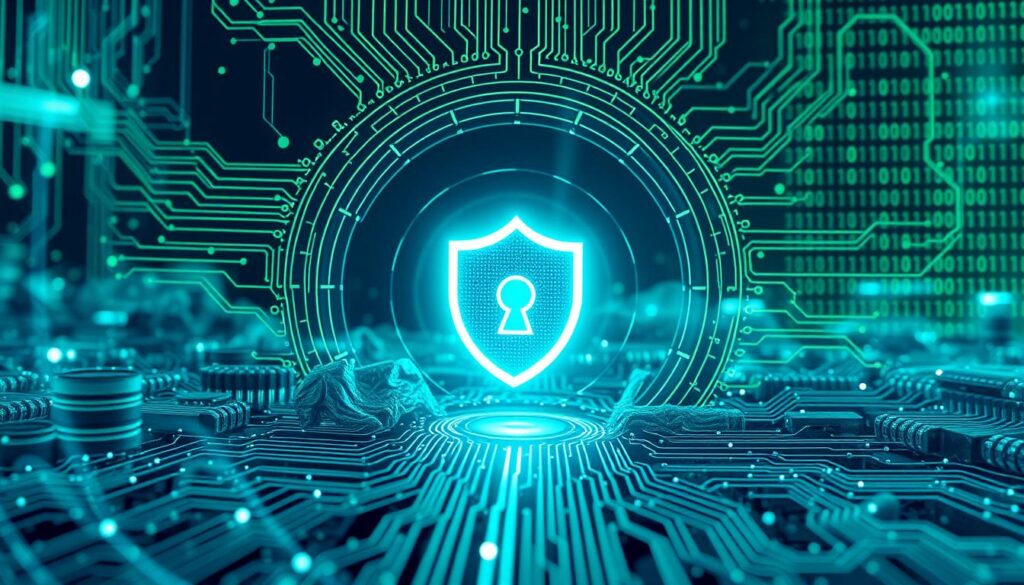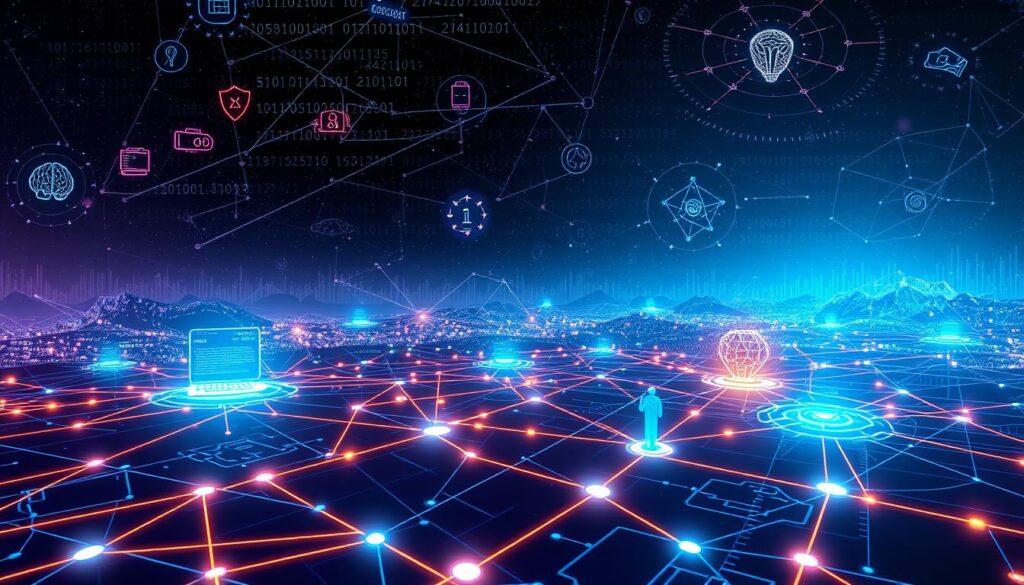In today’s fast-changing digital world, we all need strong cyber security more than ever. Our lives are deeply connected to the internet, making our personal and work data at risk. Cyber security is key to keeping our digital stuff safe from online threats.
It helps protect our sensitive info, money moves, and online actions from cybercrime. This is why cyber security is so important.
Key Takeaways
- Cyber security is key to keeping our data safe in the digital age.
- Cyber threats can really hurt individuals and businesses.
- Knowing about different cyber attacks helps us defend better.
- Using strong passwords and extra security steps makes us safer online.
- Keeping up with the latest cyber security news helps us stay safe.
Importance of Cyber Security in Today’s Digital Age
The digital world is growing fast, making cyber security very important. We use technology more and more in our daily lives and for business. This means we face more risks from cyber threats and digital vulnerabilities.
Cyber attacks can cause big problems, like personal data breaches or harming businesses and even national security.
Cyber Threats and Vulnerabilities
Cyber criminals keep finding new ways to use digital weaknesses. They use phishing scams, malware, ransomware, and data breaches. These threats can lead to identity theft, financial losses, and the loss of sensitive information.
This puts our personal and professional lives at risk.
Impact on Individuals and Businesses
Cyber attacks can be very harmful. For people, it means losing personal data, facing financial fraud, and the emotional stress of identity theft. Businesses can lose a lot of money, have a bad reputation, and face legal issues because of data breaches.
This can disrupt their work and cost a lot to fix. That’s why cyber security is so important for all kinds of businesses.
“Cyber security is not just an IT problem, it’s a business problem. The risks are too great to ignore.”
As technology keeps changing, we need strong cyber security more than ever. By understanding the threats and weaknesses, we can protect our digital stuff and stay safe online.
Understanding Cyber Attacks
In today’s digital world, cyber attacks are a big worry for both people and companies. These attacks aim to get into computer systems, networks, or data without permission. It’s important to know the different types of cyber attacks to protect ourselves.
Types of Cyber Attacks
Cyber attacks come in many forms, each with its own way of getting in and what it wants to do. Here are some common ones:
- Malware: This is bad software that tries to get into, harm, or take over a computer system. It’s often used to steal important info or mess with how things work.
- Phishing: This is when scammers use fake emails, messages, or websites to get people to share their passwords, bank info, or other private stuff.
- Ransomware: This malware locks up a victim’s files and demands money to unlock them. It can cause a lot of trouble and cost a lot of money.
- Social Engineering: This is when crooks use tricks to get people to do things that put their security at risk, like sharing passwords or giving out access to systems.
These are just a few ways cybercriminals attack. Knowing about these threats helps us build strong defenses against them.
| Cyber Attack Type | Description | Potential Impact |
|---|---|---|
| Malware | Malicious software designed to infiltrate, damage, or gain control of a computer system | Data theft, system disruption, financial loss |
| Phishing | Social engineering tactics that use deceptive emails, messages, or websites to trick users | Identity theft, financial fraud, data breaches |
| Ransomware | Malware that encrypts a victim’s files and demands a ransom payment for the decryption key | Data loss, system downtime, financial extortion |
| Social Engineering | Manipulative techniques used to exploit human psychology and trick users into compromising security | Unauthorized access, data theft, system infiltration |
“Cyber attacks are becoming more sophisticated and widespread, underscoring the need for comprehensive security measures to protect individuals and businesses alike.”
Cyber Security Best Practices
In today’s digital world, keeping your online life safe is crucial. Using cybersecurity best practices helps protect your data protection measures and digital security steps. These steps can help you and your business stay safe from cyber threats and vulnerabilities.
One key tip is to keep your software updated. Updates often fix security issues, so install them quickly. Also, turn on automatic updates to keep your devices and apps safe.
- Use strong, unique passwords for all your accounts. Avoid reusing the same password across multiple platforms.
- Enable two-factor or multi-factor authentication whenever available to add an extra layer of security to your accounts.
- Be cautious of suspicious emails, links, or attachments, as they could be part of a phishing attempt to steal your sensitive information.
- Regularly back up your important data to secure, off-site storage to safeguard against data loss in the event of a successful cyber attack.
- Consider using a virtual private network (VPN) when accessing public Wi-Fi networks to encrypt your internet connection and protect your online activities.
By following these cybersecurity best practices, you can boost your online safety. This helps protect your important data from cyber attacks. Being alert and proactive is key in the changing world of digital security.
Strengthening Passwords and Authentication
In today’s world, our online accounts and sensitive info are always at risk. That’s why strong password security and multi-factor authentication are key. Making strong, unique passwords and using more verification steps are vital to keep your digital identity safe and protect your data.
Password Management Strategies
Creating a solid password management plan is crucial to keep hackers out. Experts suggest making passwords long and complex. They should mix uppercase and lowercase letters, numbers, and special characters. Don’t use common words, personal info, or easy-to-guess patterns.
It’s also important to have a different password for each online account. Reusing passwords makes you more vulnerable to cyber threats.
- Use a password manager to safely store and create strong, unique passwords.
- Change your passwords often, especially for accounts with sensitive info.
- Don’t share your passwords with anyone, not even people you trust.
Multi-Factor Authentication
Adding multi-factor authentication (MFA) is a great way to boost security. MFA requires more verification, like a code sent to your device or a biometric like a fingerprint. This makes it hard for hackers to get into your accounts, even if they have your password.
By using strong password management and MFA, you can make your online accounts much safer. This helps protect your digital identity from cyber threats like password attacks and identity theft.
Protecting Against Malware and Viruses
In today’s digital world, malware and viruses are a big threat. They can harm both individuals and businesses. To keep your devices safe, investing in reliable anti-virus software and keeping it up-to-date is key.
Anti-Virus Software and Regular Updates
Anti-virus software is crucial for malware protection and virus prevention. Top brands like Norton, McAfee, and Kaspersky provide strong cybersecurity measures. These tools catch, stop, and remove harmful threats. But, just having the software isn’t enough. Regular system updates are needed to keep your protection strong against new cyber attacks.
- Regularly check for and install anti-virus software updates to ensure your device is protected against the latest threats.
- Enable automatic updates whenever possible to ensure your system is always running the most up-to-date version of the software.
- Consider setting your anti-virus software to automatically scan your device on a regular schedule, helping to identify and eliminate any potential infections.
By taking these steps to protect against malware and viruses, you can lower the risk of cyber attacks. This helps keep your digital world safe.
“Keeping your anti-virus software up-to-date is like wearing a seatbelt – it’s a simple precaution that can make all the difference in an emergency.”
Cyber Security for Mobile Devices
Smartphones and tablets are now key parts of our lives. They store and give us access to important info. So, keeping them safe is a big deal. We need to protect our smartphone protection and tablet security.
Keeping our apps safe is a big part of mobile device security. With so many apps out there, we must be careful when we download them. We should think about app safety to avoid malware and protect our data.
Our wireless connections are also a big risk. Whether it’s public wireless network security or our own network, we need to make them safe. This helps lower the chance of data theft and unauthorized access.
Best Practices for Mobile Device Security
- Keep your mobile operating system and apps up to date with the latest security patches and updates.
- Use strong and unique passwords or biometric authentication, like fingerprint or facial recognition, to unlock your device.
- Be careful with public Wi-Fi networks. Consider using a VPN to encrypt your internet traffic.
- Install reputable antivirus or security software on your mobile devices to detect and prevent malware infections.
- Back up your important data regularly to protect against losing or having your device stolen.
By following these tips and staying alert, we can keep our mobile device security, smartphone protection, tablet security, app safety, and wireless network security strong. This keeps our digital lives safe and private.
| Mobile Device Security Feature | Description |
|---|---|
| Biometric Authentication | Unlocking your device using fingerprint, face, or iris recognition for enhanced security. |
| Virtual Private Network (VPN) | Encrypting your internet connection to protect your online activities and data from prying eyes. |
| Antivirus Software | Detecting and preventing malware infections on your mobile device to safeguard your information. |
| Regular Backups | Backing up your data often to prevent loss and ensure you can get back important info if your device is stolen or damaged. |
Securing Your Home Network
In today’s digital age, your home network is a key entry point to the online world. It’s vital to protect it to keep your personal info, devices, and online actions safe from cyber threats. A big step in boosting your home network security is to focus on your router and firewall settings.
Router Configuration and Firewall Settings
Your home router connects all your devices to the internet. Making sure it’s set up right is key for home network security. Begin by changing the default admin username and password to something strong and unique. This stops others from getting into your router settings without permission.
- Turn on the router’s built-in firewall to block internet security threats.
- Regularly update your router with the latest firmware to get important security fixes.
- Think about turning on your router’s wireless security features, like WPA2 encryption, for better wireless network protection.
Also, setting up your router’s firewall settings can really boost your home network security. Get to know the firewall’s settings and adjust them to block unwanted traffic, limit access to certain ports, and watch network activity.
By spending time to configure your router settings and firewall, you can make your home network more secure and strong. This helps protect your digital world from different cyber threats.
Cyber Security for Businesses
In today’s digital world, cyber security is key for all businesses. Protecting digital assets and keeping operations safe is essential. This means focusing on business cybersecurity and enterprise security. It also means training employees and having a plan for when things go wrong.
Employee Training and Awareness
Employees are the first ones to spot cyber threats. Good employee cybersecurity training helps them know how to act. Teaching them about phishing scams and social engineering can lower the chance of a breach.
Incident Response and Recovery Plans
Even with strong security, cyber attacks can still happen. That’s why incident response planning and data backup and recovery are key. Having these plans helps lessen the damage from an attack and gets systems and data back fast.
Businesses must always be ready and proactive against cyber threats. By training employees, planning for incidents, and focusing on data backup and recovery, companies can protect their digital assets. This ensures their operations keep running smoothly.
Cyber Security: Protecting Your Digital World
In today’s world, cybersecurity is crucial. Our lives blend more with the online world every day. That’s why digital safety and online protection are key. This part of the article will teach you how to keep your digital world safe.
It covers the basics of data security and privacy preservation. You’ll learn how to protect your digital life. It talks about the different threats and how to fight them with strong security steps.
It also shares tips on how to manage passwords and protect your devices and network at home. By the end, you’ll feel more confident in using the internet safely.
For businesses, cyber security is very important. It talks about training employees and having plans for emergencies. Staying updated with cybersecurity news helps you stay ahead in the digital world.
“Cybersecurity is not just an IT issue, it’s a business issue. It’s about protecting your most valuable assets – your data and your reputation.”
This section is a full guide to cyber security. It helps you take charge of your digital safety and online protection. You’ll learn how to protect your personal and work data with confidence.

Staying Informed and Up-to-Date
In the fast-changing world of cybersecurity, it’s key for everyone to keep up with new info, trends, and ways to stay safe. By using trusted sources for cybersecurity news and updates, you can protect your online stuff and beat threats early.
Reliable Sources for Cybersecurity News and Updates
Finding the right info on cybersecurity isn’t hard. There are many trusted places that give the latest news and facts. Here are some top spots for cybersecurity news, security updates, and industry resources:
- Cybersecurity blogs and news sites like Krebs on Security, Dark Reading, and The Hacker News
- Industry magazines and journals, such as CSO Online, Security Magazine, and Infosecurity Magazine
- Government and industry groups, like the National Cyber Security Centre (NCSC) and the Cybersecurity and Infrastructure Security Agency (CISA)
- Cybersecurity newsletters and emails from trusted sources
- Social media, where experts share new threat intelligence and tips on staying informed
Checking these trusted sources often helps you know about new threats, best ways to stay safe, and what’s new in the field. This way, you’re ready to protect your online world.
| Source | Type of Information | Frequency of Updates |
|---|---|---|
| Krebs on Security | Cybersecurity news and analysis | Daily |
| CISA | Government cybersecurity alerts and resources | As needed |
| Cybersecurity Newsletters | Industry updates and trends | Weekly or monthly |
| Cybersecurity Subreddits | Community discussions and threat intelligence | Ongoing |
“Staying informed about the latest cybersecurity threats and best practices is crucial for protecting your digital assets. Regularly consulting reliable sources can help you stay one step ahead of potential attacks.”
Role of Governments and Regulations
In today’s fast-changing cyber world, governments and regulatory bodies are key players. Cybersecurity regulations, government policies, and data privacy laws are essential. They help protect people, businesses, and important infrastructure from cyber threats.
Governments have set up cybersecurity regulations and industry standards. These rules make sure everyone follows the same security rules. They also set out how to manage data and handle security issues.
The European Union’s GDPR and the California Consumer Privacy Act (CCPA) are big deals in data privacy laws. They change how businesses handle personal info. They give people more control over their data and have tough rules for breaking them.
Governments also focus on cybersecurity awareness and education. They teach people and businesses how to stay safe online. This helps everyone be more careful against new cyber threats.
| Regulation | Overview | Key Focus Areas |
|---|---|---|
| General Data Protection Regulation (GDPR) | A comprehensive data privacy law implemented by the European Union |
|
| California Consumer Privacy Act (CCPA) | A data privacy law enacted in the U.S. state of California |
|
Governments and regulatory bodies are key in making cybersecurity regulations, government policies, and data privacy laws. They help keep the digital world safe. They also encourage a culture of cyber resilience.
Emerging Trends and Future of Cyber Security
The digital world is always changing, and so is cyber security. Two big trends are changing the game: Artificial Intelligence (AI) and Machine Learning (ML), and the growth of the Internet of Things (IoT).
Artificial Intelligence and Machine Learning
AI and ML are making cyber security better by changing how we fight cyber threats. They look at lots of data, find patterns, and automate security tasks. This means we can stop cyber attacks faster and more accurately.
Internet of Things (IoT) Security
The IoT is growing fast, bringing new security challenges. More devices mean more chances for hackers to attack. Cyber security experts will need to focus on keeping IoT devices safe. They’ll have to make sure devices are updated securely and use strong encryption.
As cyber security changes, we’ll need to use AI, ML, and IoT security together. By doing this, we can keep our digital stuff safe and be ready for new cyber threats.

| Emerging Trend | Key Characteristics | Potential Impact |
|---|---|---|
| Artificial Intelligence and Machine Learning |
|
|
| Internet of Things (IoT) Security |
|
|
Conclusion
In today’s digital world, strong cyber security is key. This article has shown us the many threats and weaknesses we face. It also shared important steps to keep our digital world safe.
We learned about making strong passwords and using multi-factor authentication. We also learned how to fight against malware and keep mobile devices safe. These steps help us protect our online safety.
Looking ahead, we must stay alert and adapt to new cyber threats. It’s important to keep up with the latest news and use new tech like AI and IoT. We also need strong rules to keep our digital future safe.
By doing these things, we can handle the changing cyber security scene. This way, we protect our personal and work digital spaces.
To wrap it up, cyber security is vital in our connected world. By following the advice in this article, we can keep our online activities safe. This leads to a more secure and bright digital future.



